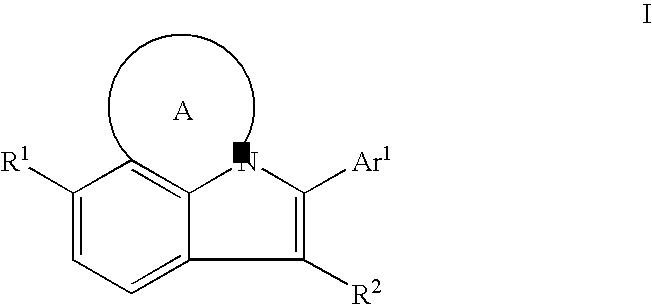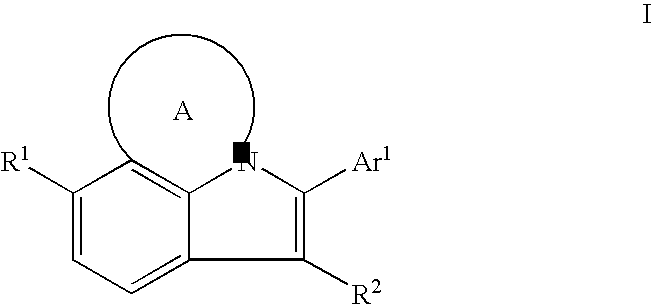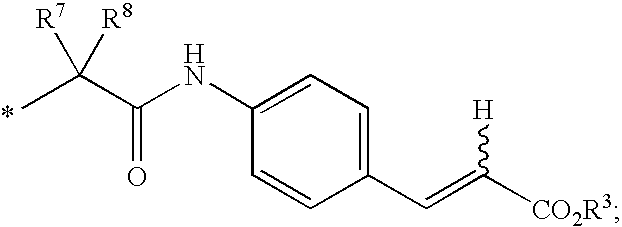HCV NS5B Inhibitors
a technology of hcv and inhibitors, applied in the direction of heterocyclic compound active ingredients, biocide, drug compositions, etc., can solve the problem that a large percentage of patients do not have a sustained reduction in viral load
- Summary
- Abstract
- Description
- Claims
- Application Information
AI Technical Summary
Problems solved by technology
Method used
Image
Examples
example 1
[0088]
[0089]6-cyclohexyl-2,3-dihydro-5-phenyl-1,4-oxazino[2,3,4-hi]indole-9-carboxylic acid. To a mixture of the alcohol (1H-indole-6-carboxylic acid, 7-chloro-3-cyclohexyl-1-(2-hydroxyethyl)-2-phenyl-, methyl ester) (27.4 mg, 66.5 μM) in DMSO (1.0 ml) under N2 at r.t. in a microwave reaction tube was added NaH (5.3 mg, 133 μmol, 60% in oil), and the reaction mixture stirred for about 10 min. The reaction mixture was then placed under microwave irradiation in an Emrys Optimizer (Personal Chemistry) at 200° C. and with the absorption level set to high for 10 min. The mixture was then diluted with water (1 ml) and acidified with hydrochloric acid (1N). The solid was filtered, washed with water (1 ml) and dried. Purification by preparative thin layer chromatography (500 μm×20 cm×20 cm plate) using 5% MeOH / CH2Cl2 as eluent gave (1,4-oxazino[2,3,4-hi]indole-9-carboxylic acid, 6-cyclohexyl-2,3-dihydro-5-phenyl-) as an off white solid. 1H NMR (300 MHz): (CD3OD) δ 7.59-7.44 (d overlapping w...
example 2
[0090]
[0091]6-cyclohexyl-N-[(dimethylamino)sulfonyl]-2,3-dihydro-5-phenyl-1,4-oxazino[2,3,4-hi]indole-9-carboxamide. To the acid (1,4-oxazino[2,3,4-hi]indole-9-carboxylic acid, 6-cyclohexyl-2,3-dihydro-5-phenyl-) (11.4 mg, 31.5 μmol) in a round-bottomed flask at r.t. under N2 was added a solution of 1,1′-carbonyldiimidazole (CDI) (10.2 mg, 62.9 μmol) in THF (1 ml), and the mixture was stirred at 50° C. for 2 hr. After cooling to r.t., the reaction mixture was added a mixture of N,N-dimethylsulfamide (15.6 mg, 126 μmol) and DBU (21.6 mg, 142 μmol) in THF (0.5 ml), and then stirred at 50° C. for 20.5 hr. After cooling to r.t., the volatiles were evaporated and the residue added hydrochloric acid (1.5 ml, 1N). The aqueous mixture was removed by pipet, and the solid residue purified by preparative thin layer chromatography (250 μm×20 cm×20 cm plate) using 5% MeOH / CH2Cl2 as eluent to give the product, which was then further purified by preparative thin layer chromatography (250 μm×20 cm×...
example 3
[0092]
[0093](2E)-3-[4-[[[1-[[(6-cyclohexyl-2,3-dihydro-5-phenyl-1,4-oxazino[2,3,4-hi]indol-9-yl)carbonyl]amino]cyclopentyl]carbonyl]amino]phenyl]-2-propenoic acid, ethyl ester. To a mixture of the acid 1,4-oxazino[2,3,4-hi]indole-9-carboxylic acid, 6-cyclohexyl-2,3-dihydro-5-phenyl- (23.5 mg, 65 μmol) in DMF (1 ml) at r.t. under N2 was added the amine (40 mg, 132 μmol), 2-(1H-benzotriazole-1-yl)-1,1,3,3-tetramethyluronium tetrafluoroborate (TBTU) (65 mg, 197 μmol) and then N,N-diisopropylethylamine (45 μl, 258 μmol), and the reaction mixture stirred at r.t. for 20 hr. The volatile was evaporated and the residue added hydrochloric acid (2 ml, 1N). After removing the aqueous mixture was removed by pipet, the residue was washed with water (2 ml). The aqueous mixture was again removed by pipet. The residue was dried, and purified by Biotage flash chromatography (gradient elution, 0 to 50% EtOAc / Hexane) gave the amide (2-propenoic acid, 3-[4-[[[1-[[(6-cyclohexyl-2,3-dihydro-5-phenyl-1,4-...
PUM
 Login to View More
Login to View More Abstract
Description
Claims
Application Information
 Login to View More
Login to View More - R&D
- Intellectual Property
- Life Sciences
- Materials
- Tech Scout
- Unparalleled Data Quality
- Higher Quality Content
- 60% Fewer Hallucinations
Browse by: Latest US Patents, China's latest patents, Technical Efficacy Thesaurus, Application Domain, Technology Topic, Popular Technical Reports.
© 2025 PatSnap. All rights reserved.Legal|Privacy policy|Modern Slavery Act Transparency Statement|Sitemap|About US| Contact US: help@patsnap.com



